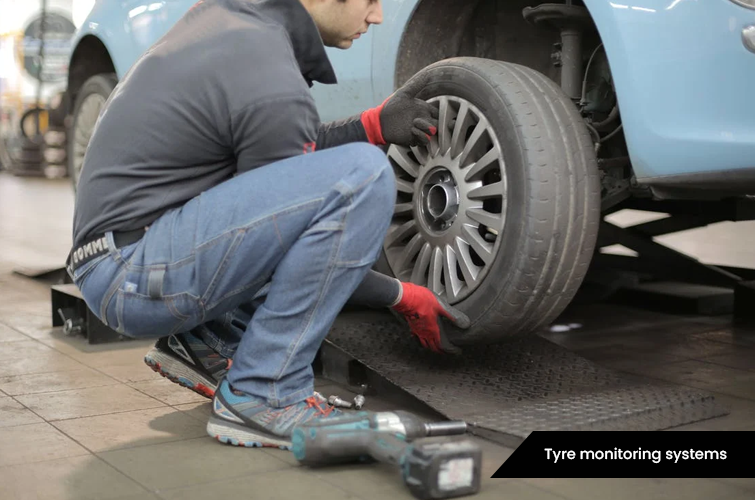What is the Purpose of Tyre Monitoring Systems?
Summary
The article discusses the importance of tyre monitoring systems in fleet management. It explains the essential components and types of tyre pressure monitoring systems and their pros and cons.
Proper tyre pressure helps maintain the stability, durability, and fuel efficiency of a fleet, while low tyre pressure can cause accidents, flat tyres, punctures, and increased fuel consumption.
An efficient tyre monitoring system helps prevent accidents and saves time and cost.
Fleet business involves a lot of parameters that run successfully to execute day-to-day activities in a proper manner. One of the crucial parts of the fleet is tires.
Fleets go through various types of roads and the tires help to maintain stability and durability for your fleets. Tiring with less or excess air pressure can lead to various issues during a journey.
Flat tires and other problems also cause loss and waste of time to your fleets. These days people install a tire monitoring system in their fleets to keep a check on tire’s health.
Read below to know more about the purpose and function of tyre pressure monitoring systems.

What is the essential element of the Tyre Monitoring System?
The tyre monitoring system is designed in such a way that it keeps track of everything that happens to your fleet tires.
One of the most essential components of your truck’s tire management system is the Tire Pressure Monitoring System.
The Tyre Pressure Monitoring System keeps in check the air pressure levels inside your tires. Air pressure is one of the most essential parameters that affect the health of the tyres.
In case of drop-in levels of air pressure, the tire pressure monitoring system notifies the driver and saves the fleet from any kind of accident or damage.
Types of Tyre Pressure Monitoring System
The Tyre pressure monitoring system is categorized into different types depending on the mechanism of their working.
Read below to know about the two most popular kinds of Tire Pressure Monitoring Systems used in fleets-
The Direct/Active Tire Pressure Monitoring System
The first type of Tyre Pressure Monitoring System is the Direct Tire Pressure Monitoring System. In this type of system, the reading of air pressure in different tires of the fleets is recorded directly from the tires.
An air pressure recording sensor is installed on every tire. These sensors take a constant reading of the air pressure in the tires. In case of a decrease in air pressure below 25 percent, the sensors give an emergency notification.
This method is more accurate and gives an exact reading of the air present in the tires. The percentage of accuracy is close to a perfect hundred! This helps the fleet managers to prevent any kind of accidents.
The Direct Tire Monitoring System is durable and can be used again and again as the batteries used in the sensors can last for years. This gives it an extra edge and makes it a tool of long use.
The Direct Tire Monitoring System is not a cost-friendly option. It is more expensive compared to other kinds of Tire Pressure Management systems. The sensors installed over every tire are costly and add up to the total sum of money.
The reinstallation of the direct tire monitoring system in case a tire gets damaged is a tedious process. It requires a high level of skill set to remove and resynchronize the system altogether.
The Direct Tire Pressure Monitoring System mostly comes with single-use batteries. The batteries last longer but once they are drained the batteries become useless. You need to reinstall all sensors again in your fleet for proper functioning.
You need to keep good care of the sensors used in Direct Tire Pressure Monitoring Systems. They are prone to damage if not taken care of.
The Indirect/Passive Tire Pressure Management System
Another method by which Tyre Pressure Monitoring System works is the Indirect/Passive Tyre Pressure Management System. In this method, there are no sensors directly installed on tires.
In most cases, the sensors are installed in the tire speed tracking system. The system looks out at revolutions per minute in the tires. In the case of inflated tires or lower levels of air pressure, the revolutions per minute get disturbed as compared to other tires in the fleet.
The tyre pressure management system calculates the approx air pressure level in the fleet with the help of tire revolutions and alerts the fleet manager and driver about this through the notification screen.
The Indirect Tire Pressure Management System is not as accurate as the direct tire pressure management system. It is relatively approximate and sometimes the readings can fluctuate due to other reasons.
In case of bad roads or rough roads, the revolutions per minute of the tires are affected and hence the indirect system can give you a false calculation.
It is cheaper compared to the direct Tire pressure management system. The cost of installation of an Indirect Tire Pressure Management System is less than the Direct Tire Pressure Management System,
The maintenance charges of the indirect Tire Monitoring System are also very less compared to the Direct Tire Management System.
How Important it is to Keep Track of Your Tyre’s Health?
Telematics based Tyre Monitoring System is making it possible to keep track of your tire health. But, there are chances that you may question if there is any need to know about your tire’s health? Does it make any difference?
Well, the answer can surprise you a lot. Tires are one of the most essential components of your fleet and can affect its performance to a large extent.
The fuel consumption of your fleet can increase to a significant amount if the vehicle is running on air pressure levels lower than the optimum ones. Perfect air pressure levels might save you money by giving higher efficiency over the same fuel.
Tyres provide stability to the vehicle. If your fleet’s tires are having the required amounts of air pressure the fleet runs on even balance and chances of turning off the vehicle in case of an accident are minimized.
In case of lower levels of air pressure, the tires can get flat or punctured causing trouble to the driver and a lot of time wastage.
In many cases, the bursting of tires can take place. There are high chances that vehicles can lose stability and turn over the road.
An efficient Tire Monitoring System keeps track of the health of your tires and saves a lot of cost and time.
Summing it up!
The tyre management system is becoming an essential part of fleet management. Tires are one of the most significant parts of your vehicles.
Tyre monitoring systems ensure that your vehicle tires are in good health. They keep track of air pressure levels and secure stability and efficiency.
Direct and indirect methods of execution are used by Tire monitoring systems. Install a tire monitoring system in your vehicle and ensure safety!
Team VAMOSYS
Team VAMOSYS have been into GPS business since 2014 and have good experience on GPS Vehicle Tracking, Fuel Monitoring, Fleet Management and GPS Tracker Devices. Writes article on various topics to share the industry experiences and knowledge.

